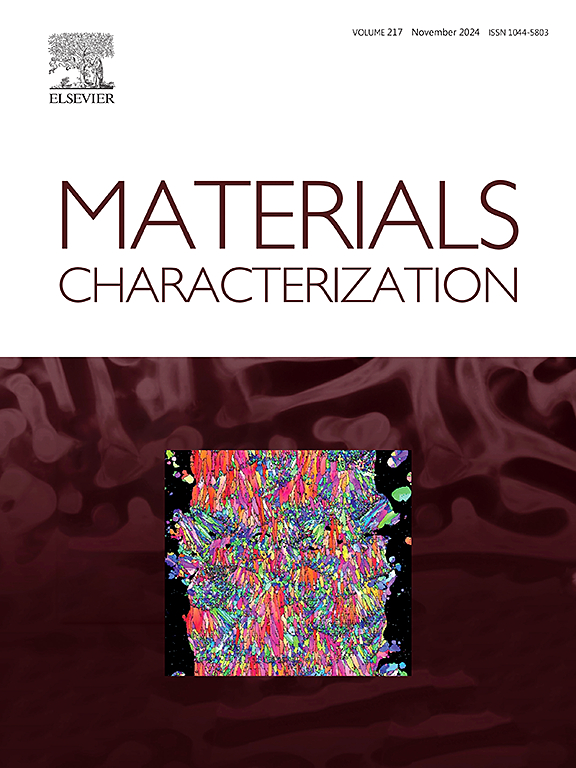[011]取向镍基单晶高温合金750℃蠕变过程中层错和孪晶的形成机制
IF 5.5
2区 材料科学
Q1 MATERIALS SCIENCE, CHARACTERIZATION & TESTING
引用次数: 0
摘要
研究了镍基单晶高温合金CMSX-4在750℃/670 MPa[011]取向蠕变后的显微组织。采用像差校正透射电镜对γ基体和γ′析出相中的内禀和外源性层错、微孪晶等变形缺陷的类型和形态进行了分析。结果表明,在γ/γ′界面处,由于a/2 < 101 >和a/2 < 110 >基体位错的相互作用,导致单个a/3 < 211 >位错的剪切,在γ′析出相中产生超晶格本征层错。超晶格外源层错的形成有两种机制:相邻{111}平面上两个a/3 < 211 >位错的连续剪切机制,以及相邻平面上两个相同基体位错产生的两个相同a/6 < 211 >部分位错的两两剪切机制。根据对各类型堆积断层数量的统计研究,a/3 < 211 >位错剪切主导蠕变变形。此外,这两种机制的共同作用导致变形孪晶的形成,变形孪晶可以剪切大量的γ通道和γ′沉淀。这些结果为进一步了解镍基单晶高温合金在中温条件下的蠕变变形提供了依据,对设计和开发新型材料具有重要意义。本文章由计算机程序翻译,如有差异,请以英文原文为准。
![Formation mechanisms of stacking faults and twins during creep deformation of a [011] oriented nickel-based single crystal superalloy at 750 °C](https://img.booksci.cn/booksciimg/2025-6/102305088761782654473.jpg)
Formation mechanisms of stacking faults and twins during creep deformation of a [011] oriented nickel-based single crystal superalloy at 750 °C
The microstructure of the nickel-based single crystal superalloy CMSX-4 was investigated after [011]-oriented creep deformation at 750 °C/670 MPa. Aberration-corrected transmission electron microscopy was used to identify the types and configurations of deformation defects, such as intrinsic and extrinsic stacking faults and microtwins in both γ matrix and γ' precipitates. The findings demonstrated that the shearing of single a/3〈211〉 dislocations, which resulted from the interaction of a/2〈101〉 and a/2〈110〉 matrix dislocations at the γ/γ' interfaces, produced superlattice intrinsic stacking faults in γ' precipitates. Superlattice extrinsic stacking faults were formed through two mechanisms: successive shearing of two a/3〈211〉 dislocations on two neighboring {111} planes, and pairwise shearing of two identical a/6〈211〉 partial dislocations, which originated from two identical matrix dislocations on adjacent planes. Shearing of a/3〈211〉 dislocations dominates creep deformation, according to statistical study of the number of each type of stacking fault. Moreover, the combination of these two mechanisms resulted in the formation of deformation twins, which can shear through numerous γ channels and γ' precipitates. These results provide a further understanding of creep deformation of nickel-based single crystal superalloys at intermediate temperatures, which is essential for designing and developing novel materials.
求助全文
通过发布文献求助,成功后即可免费获取论文全文。
去求助
来源期刊

Materials Characterization
工程技术-材料科学:表征与测试
CiteScore
7.60
自引率
8.50%
发文量
746
审稿时长
36 days
期刊介绍:
Materials Characterization features original articles and state-of-the-art reviews on theoretical and practical aspects of the structure and behaviour of materials.
The Journal focuses on all characterization techniques, including all forms of microscopy (light, electron, acoustic, etc.,) and analysis (especially microanalysis and surface analytical techniques). Developments in both this wide range of techniques and their application to the quantification of the microstructure of materials are essential facets of the Journal.
The Journal provides the Materials Scientist/Engineer with up-to-date information on many types of materials with an underlying theme of explaining the behavior of materials using novel approaches. Materials covered by the journal include:
Metals & Alloys
Ceramics
Nanomaterials
Biomedical materials
Optical materials
Composites
Natural Materials.
 求助内容:
求助内容: 应助结果提醒方式:
应助结果提醒方式:


